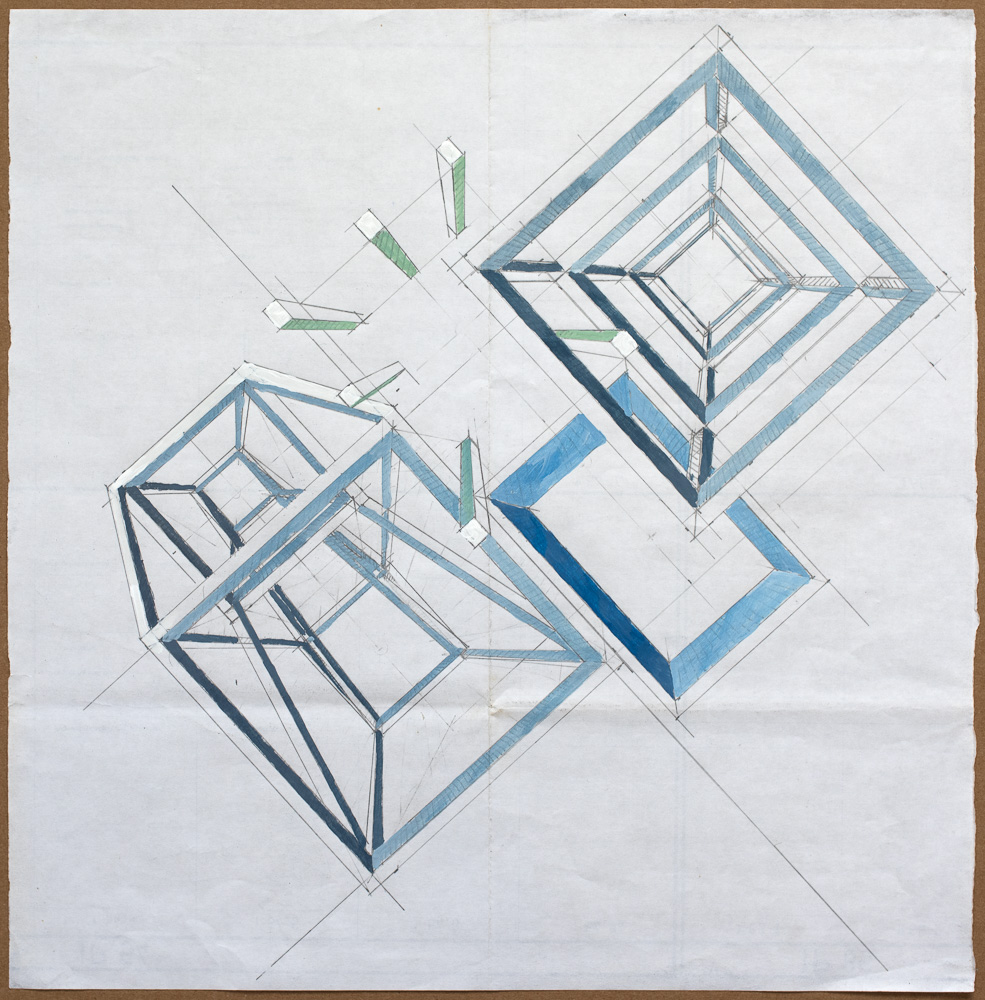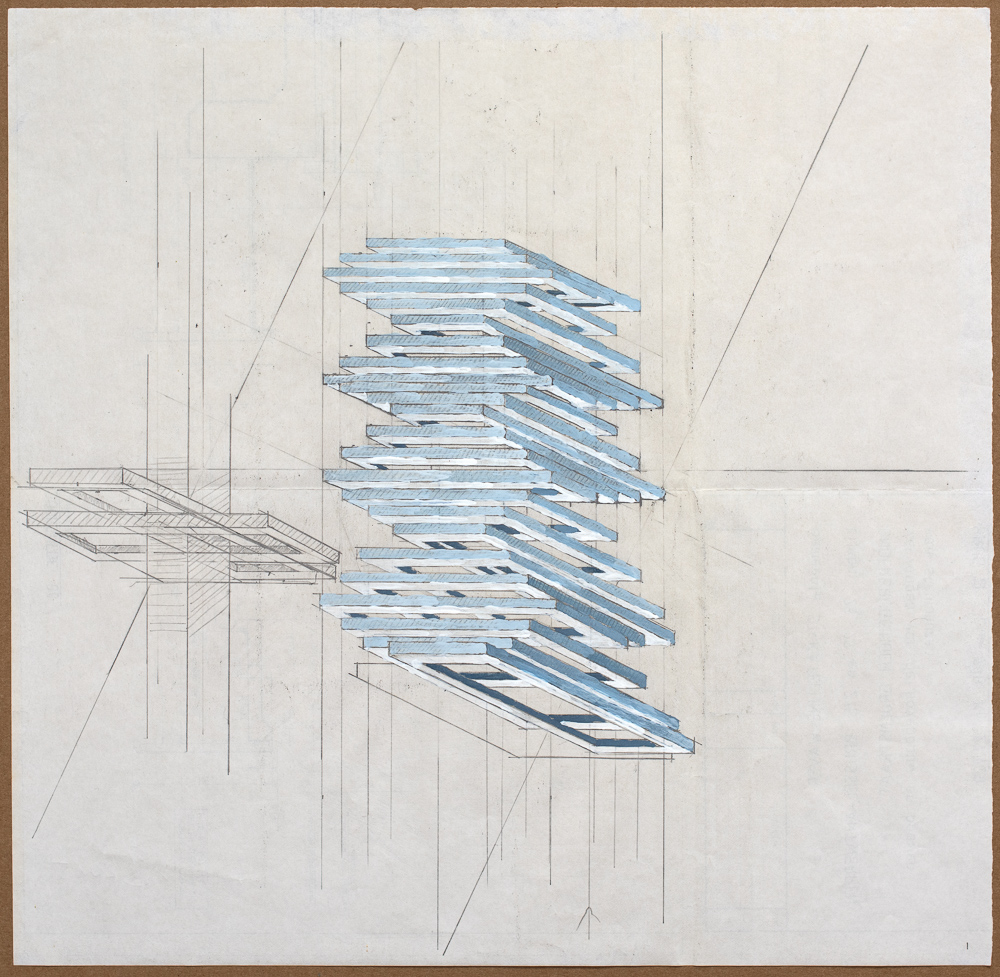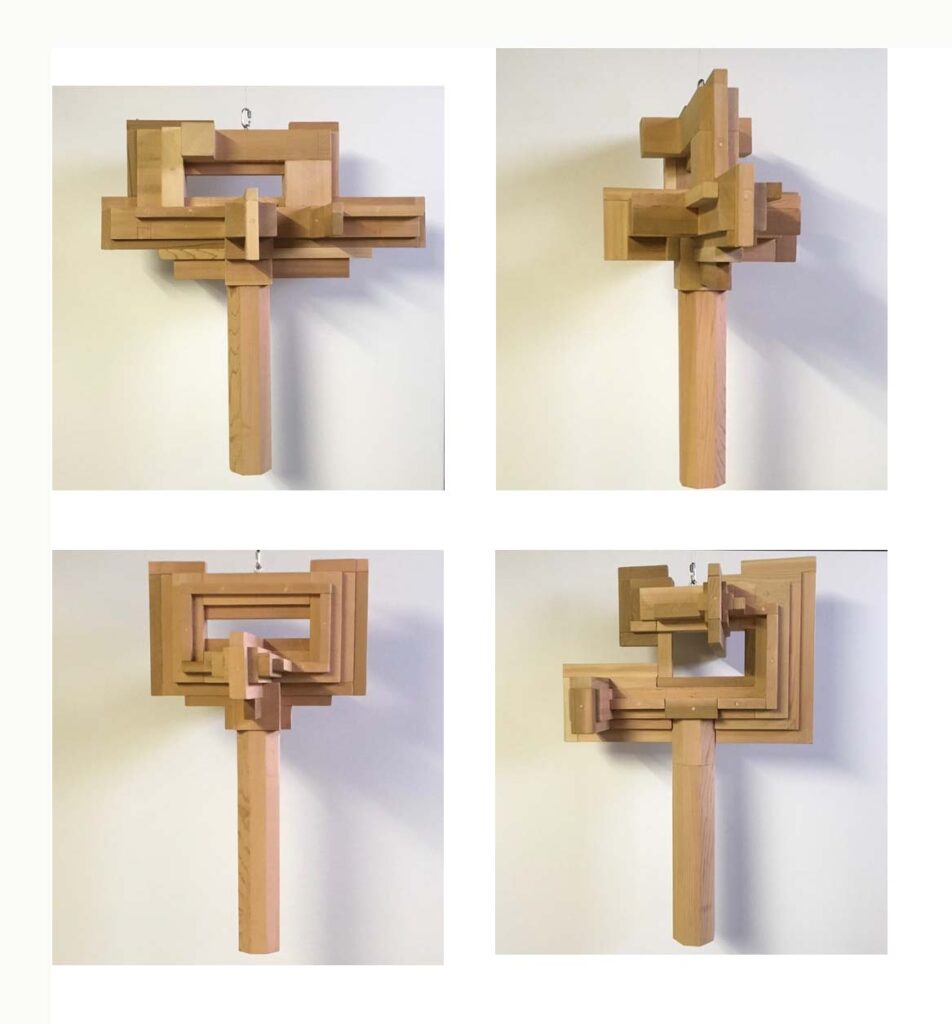Karel Breugelmans: WHERE NO MAN HAS GONE BEFORE | Waar geen mens ooit was
Opening zondag 23 februari, 14 -18 uur,
receptie Corsendonk bier
Exhibition with recent and older work & presentation of new book | Tentoonstelling van recent naast ouder werk en voorstelling nieuw boek: Karel Breugelmans 2015 – 2025
Open from 23.02 until 23.03.2025
Friday, Saturday & Sunday, 2 – 6 pm | Vrijdag, zaterdag & zondag 14 – 18 uur
or by appointment | of na afspraak
Geometric-looking constructions float in the blue-grey void of the canvas. Their cedarwood and mirrored sculptural counterparts hang freely from a tree or from the ceiling, or they rest on a plinth, stretching skywards. The strikingly consistent oeuvre of Karel Breugelmans – who, for decades, has stood outside every trend and even movement – refers to architecture but never becomes it. Instead his work embodies an exploration of space in every sense of the word.
Geometrisch ogende constructies zweven in de blauwgrijze leegte van een schildersdoek. Hun cederhouten of spiegelende, sculpturale tegenhangers hangen vrij in een boom, aan het plafond, of staan op een sokkel en reiken naar de lucht. Het zeer consistente oeuvre van Karel Breugelmans, al decennialang wars van zowat elke trend en zelfs stroming, refereert naar architectuur, maar ís het niet. Wel is het een exploratie van ruimte, in alle betekenissen van het woord.
Tamara Beheydt, 2024

Fourth Dimension 4, 2024, gouache, 42 x 42 cm
In drawings, paintings and objects, Breugelmans is not concerned with one single big idea, but with the parallel existence of atmospheres, a parallelism and simultaneity of ideas which possibly consider the ‘mixed city’ as the most obvious solution.
In tekeningen, schilderijen en sculpturen heeft Breugelmans het niet over een enkel groot idee, maar over een naast elkaar bestaan van atmosferen, een parallelliteit en gelijktijdigheid van idealen die mogelijkerwijze de ‘vermengde stad’ als het meest voor de hand liggend beschouwen.
Christophe Tannert, 2014

Studie 2, 2015, ink and tempera on architects paper, 42 x 42 cm
Nieuwe publicatie | new book, tekst | text Tamara Beheydt:
CONSTRUCTIES 2015-2025
‘WAAR GEEN MENS OOIT WAS’, RUIMTE, UTOPIE EN HET MENSELIJKE IN HET WERK VAN KAREL BREUGELMANS
‘WHERE NO MAN HAS GONE BEFORE’, SPACE, UTOPIA AND HUMANITY IN THE WORK OF KAREL BREUGELMANS
Tamara Beheydt
Fragmenten | fragments :
Geometrisch ogende constructies zweven in de blauwgrijze leegte van een schildersdoek. Hun cederhouten of spiegelende, sculpturale tegenhangers hangen vrij in een boom, aan het plafond, of staan op een sokkel en reiken naar de lucht. Het zeer consistente oeuvre van Karel Breugelmans, al decennialang wars van zowat elke trend en zelfs stroming, refereert naar architectuur, maar ís het niet. Wel is het een exploratie van ruimte, in alle betekenissen van het woord.
Geometric-looking constructions float in the blue-grey void of the canvas. Their cedarwood and mirrored sculptural counterparts hang freely from a tree or from the ceiling, or they rest on a plinth, stretching skywards. The strikingly consistent oeuvre of Karel Breugelmans – who, for decades, has stood outside every trend and even movement – refers to architecture but never becomes it. Instead his work embodies an exploration of space in every sense of the word.
Zijn constructies kunnen ook een verbeelding zijn van geestelijke materie en het menselijke (persoonlijke en collectieve) bewustzijn als een fysieke plaats. Hij verwijst ook niet voor niets naar grijze cellen wanneer hij het kleurenpalet van zijn schilderijen bespreekt. De grijze materie is een deel van het centrale zenuwstelsel dat de hersenschors vormt, waar informatie uit andere delen van het lichaam via zenuwbanen ontvangen en verwerkt wordt. Het is als het ware de ruimte waar zintuiglijke kennis ontstaat.
His constructions can also be viewed as a representation of the mind and human consciousness (personal and collective) as a physical place. It’s no coincidence that he refers to grey cells in the colour palette of his paintings. Grey matter is a part of the central nervous system that forms the cerebral cortex, where information from other parts of the body is received and processed via neural pathways.18 One could say it is the space where sensory knowledge emerges.
Doorheen de jaren kregen Breugelmans’ werken steeds minder elementen uit bestaande architecturale ruimtes en steeds meer mentale ruimte. Zijn recentste werk gaat meer dan ooit over een potentiële ruimte, de denkbare mogelijkheden van constructies in een universum dat we als mens nog volop verkennen.
Over the years, Breugelmans’ works have taken fewer elements from existing architectural spaces and more from mental space. More than ever before, his most recent work concerns a potential space, the conceivable possibilities of constructions in a universe we are still exploring.
Hoewel er in de verste verte geen levende figuur te bekennen valt, is zijn werk inherent humanistisch. Het gaat over welke ruimte de mensheid voor zichzelf inneemt, verovert, vernielt en (herop)bouwt; hier, nu, op deze planeet, in de eigen geest, of ooit ver weg, in ‘de ruimte’.
Although he never depicts humans, his work remains inherently humanistic. It deals with the space that we as a species occupy, conquer, destroy and (re)build – in the here and now, on this planet, in our own minds and perhaps, one day, far off in ‘space’.
Meer foto’s en kunstenaarspagina | more photos and artist page
